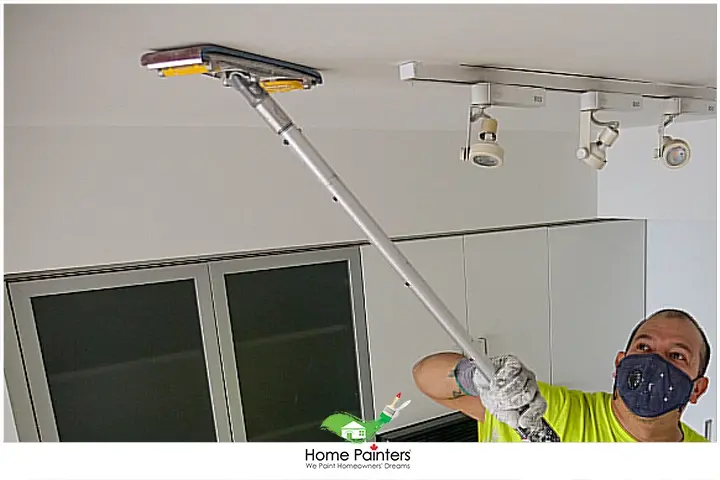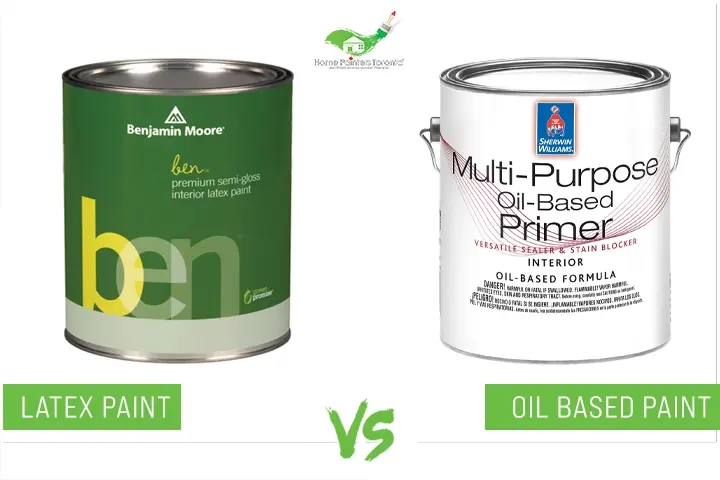
Painting ceilings can always be a bit tricky. Particularly, painting bathroom ceilings tends to be the part that intimidates a lot of people. Perhaps because you tend to deal with a lot of peeling ceiling paint issues before painting. The good news is that there are efficient ways to paint ceilings — bathrooms and otherwise. We’re here to help guide you through all the details of ceiling paint!
Understanding Ceiling Paint
Ceiling paint is a unique type of paint specifically formulated for painting ceilings. Unlike regular wall paints, ceiling paint is typically thicker with a flat finish. This unique formulation is designed to hide common ceiling imperfections and prevent splatters, providing a flawless, subtle finish that doesn’t draw attention away from your walls and decor.
Why Choose Ceiling Paint?
- Non-reflective finish: Ceiling paint usually has a flat or matte finish that does not reflect light, which creates a smooth surface that helps hide imperfections like cracks, bumps or patches.
- Splatter resistance: Ceilings can be challenging to paint due to the risk of paint splattering back at you. Ceiling paint is specifically formulated to be thicker and resist splattering, making for a much cleaner painting experience.
- Spectacular coverage: Ceiling paint is designed to cover stains, discolouration, and previous paint colours effectively in fewer coats than regular paint.
- Availability in a wide range of colours: While traditionally, ceilings are painted white or off-white, modern interior design trends are increasingly leaning towards coloured ceilings. Most brands offer ceiling paint in a range of colours, allowing you to add a dash of personality to your space.
How to Choose the Right Ceiling Paint
- Consider the room: The selection of ceiling paint can depend on the specific room. Kitchens and bathrooms might require paint that resists moisture and mildew, while in bedrooms and living rooms, regular ceiling paint will usually do.
- Choose the right finish: Ceiling paint usually comes in flat finishes. However, if you want a little sheen, you can consider a satin or eggshell finish too. Keep in mind that shiny finishes will highlight ceiling imperfections.
- Select the right colour: Recent design trends have begun to break away from the standard white ceiling. Choosing a ceiling colour doesn’t have to be monotonous — you can opt for shades that complement, contrast, or even match your wall paint.


Bathroom Ceiling Paint
For ceiling paint for the bathroom, you should purchase a satin or eggshell sheen. This is because it will help shield any watermarks. A lot of people believe that the higher the sheen, the more washable it is, but this is not always the case.
Semi-gloss is way too shiny for a bathroom ceiling. This is because the sheen is too high, which will make it easier for everyone to notice the imperfections. You should typically not use anything higher than an eggshell or satin. Try to purchase high-quality paint because it’s more durable and can withhold any imperfections.
Paint for Kitchen Ceiling and Cabinetry
For kitchen ceilings, professional painters will advise you to get satin or semi-gloss paint because they are both easier to wipe down. As far as kitchen cabinetry, if they are in good condition, they can be painted to suit your aesthetic and style. You should typically use a semi-gloss sheen for kitchen cabinets, like the ADVANCE Interior Paint- Semi Gloss from Benjamin Moore.
A painting company that is tackling the job should scrub and lightly sand the cabinets. Then, apply a primer and finish with enamel paint for the best results. To check out the full kitchen cabinet painting process, check out this blog here.
Ceiling Paint For Hallways, Living Room and Bedrooms
In high-traffic areas like hallways, you will need paint that has a satin finish. This is because they resist the dreaded marks left by bumps and rubs when people move across the hall. If you use a flat finish, for example, you will see all the fingerprints.
Satin paint is a better option because it stays cleaner as the dirt does not grip the slick surface as much as a flat finish would. For a living room or bedroom, you should use a satin or eggshell finish because it would be a flattering look. Lastly, for a bedroom door, you should want to use semi-gloss paint. This is because it will withstand the constant dirt on the handles and shackles.

Invest in Semi-Gloss Paint
When you are showering or taking a hot bath, your windows will get foggy because of the humidity. This humidity can lead to chipping and peeling on your wall and bathroom ceiling. How do we fix that problem?
You would need to invest in semi-gloss paint. Semi-gloss paint is a perfect choice because it is washable, durable, and mildew-resistant. In addition, ceilings produce mould and mildew because the average person is not cleaning their ceilings every day (it’s pretty high). By using semi-gloss paint, it will protect your bathroom ceiling from mildew, while being durable as well.
Latex Vs. Oil Based Paint
The right type of paint for a bathroom would be water-based latex paint. Although oil paint is more durable, you need to clean it with mineral spirits, and that causes VOCs (volatile organic compounds) to develop.
In addition, oil paint can develop yellow, especially in dark rooms. Latex paint is better suited for bathrooms because it doesn’t allow water to penetrate, and that’s important when showering or using the sink.
Also, you can scrub away stains more easily using latex paint than you would with oil-based paint. In its totality, latex paint is not only easier to use but dries quicker and those are two things people love to hear.

How to Paint a Ceiling Like a Pro: Tips and Tricks
- Start with primer: Using a primer can help make your paint job go smoother and faster, ensuring better paint adhesion and consistent colour.
- Use a paint roller: For the best results, use a paint roller rather than a brush. Rollers cover large areas more evenly, ensuring a smooth, seamless finish.
- Paint in sections: When painting, work in small sections to prevent the edges from drying and leaving visible lines.9
- Apply at least two coats: While ceiling paint is designed for superior coverage, applying at least two coats ensures an even finish without any peek-throughs.
- Don’t forget safety: Always ensure you’re using a sturdy ladder or scaffolding. Safety should come first, especially when painting overhead.
Top Related Blogs Related to
“YOUR GUIDE TO CEILING PAINT”
If you reside in Toronto and the GTA and need some help to paint a ceiling? don’t hesitate to call us! We will help you pick the colours you want and show you the latest painting and home renovation trends. Our home painting services with the best pro painters have been around now for over 36 years. Call 416.494.9095 or email [email protected] for a FREE quote for your home painting needs. And don’t forget to check us out on our social media channels below!





